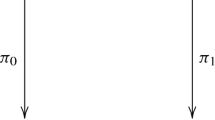Abstract
A canonical formalism based on the geometrical approach to the calculus of variations is given. The notion of multi-phase space is introduced which enables to define whole the canonical structure (physical quantities, Poisson bracket, canonical fields) without use of functional derivatives. All definitions are of pure geometrical (finite dimensional) character.
The observable algebra\(\mathcal{O}\) (physical quantities algebra) obtained here is much smaller then the algebra of all (sufficiently smooth) functionals on the space of states, derived from the standard infinite-dimensional formulation. As it is known, the latter is much too large for purposes of quantization. As the examples prove, our algebra\(\mathcal{O}\) could be an adequate start-point for quantization.
For simplifying the language the notion of observable-valued distribution is introduced. Many concrete physical examples are given. E.g. it is shown that some problems connected with gauge in electrodynamics are automatically solved in this approach. The introduced language allows to obtain the Noether theorem in a most natural way.
Similar content being viewed by others
References
Bergman, P. G.: Status of canonical quantization, preprint.
Białynicki-Birula, I., Białynicka-Birula, Z.: Elektrodynamika Kwantowa, Warszawa: Państwowe Wydawnictwo Naukowe 1969.
Białynicki-Birula, I.: Gauge invariant canonical formalism, Reports on Math. Phys.1, 83–86 (1970).
Białynicki-Birula, I.: Solutions of the Equations of Motion in Classical and Quantum Theories. Ann. Phys.67, (1) 252–273 (1971).
Bishop, R. L., Critenden, R. J.: Geometry of Manifolds. New York: Academic Press 1964.
Dedecker, P.: Calcul des variations, formes différentielles et champs géodésiques, Colloque International de Géometrie Différentielle. Straßbourg 1953.
Eells, J., Jr.: On the geometry of function spaces. Symp. Inter. de Topologia Alg., Mexico 303–308, 1956–1958.
Gawedzki, K.: On the geometrization of the canonical formalism in the classical field theory, Reports on Math. Phys. (in print).
Kijowski, J.: Existence of differentiable structure in the set of submanifolds. Studia Math.33, 93–108 (1969).
Kijowski, J.: On representation of functionals of local type by differential forms, Colloquium Mathematicum,26, 293–312 (1972).
Marsden, J. E.: Generalized Hamiltonian Mechanics. Arch. Rat. Mech. Anal.28, 323–361 (1968).
Marsden, J. E.: Hamiltonian One Parameter Groups. Arch. Rat. Mech. Anal.28, 362–394 (1968).
Maurin, K.: Analiza, Warszawa: Państwowe Wydawnictwo Naukowe 1971.
Segal, J. E.: Mathematical Problems of Relativistic Physics, Proceedings of the Summer Seminar, Boulder, Colorado, 1960.
Tulczyjew, W. M.: Seminar on Phase Space Theory. Warsaw 1968 (unpublished).
Tulczyjew, W. M., Sniatycki, J.: Canonical dynamics of relativistic charged particles. Ann. Inst. H. Poincaré A,15, 177–187 (1971).
Author information
Authors and Affiliations
Rights and permissions
About this article
Cite this article
Kijowski, J. A finite-dimensional canonical formalism in the classical field theory. Commun.Math. Phys. 30, 99–128 (1973). https://doi.org/10.1007/BF01645975
Received:
Revised:
Issue Date:
DOI: https://doi.org/10.1007/BF01645975




